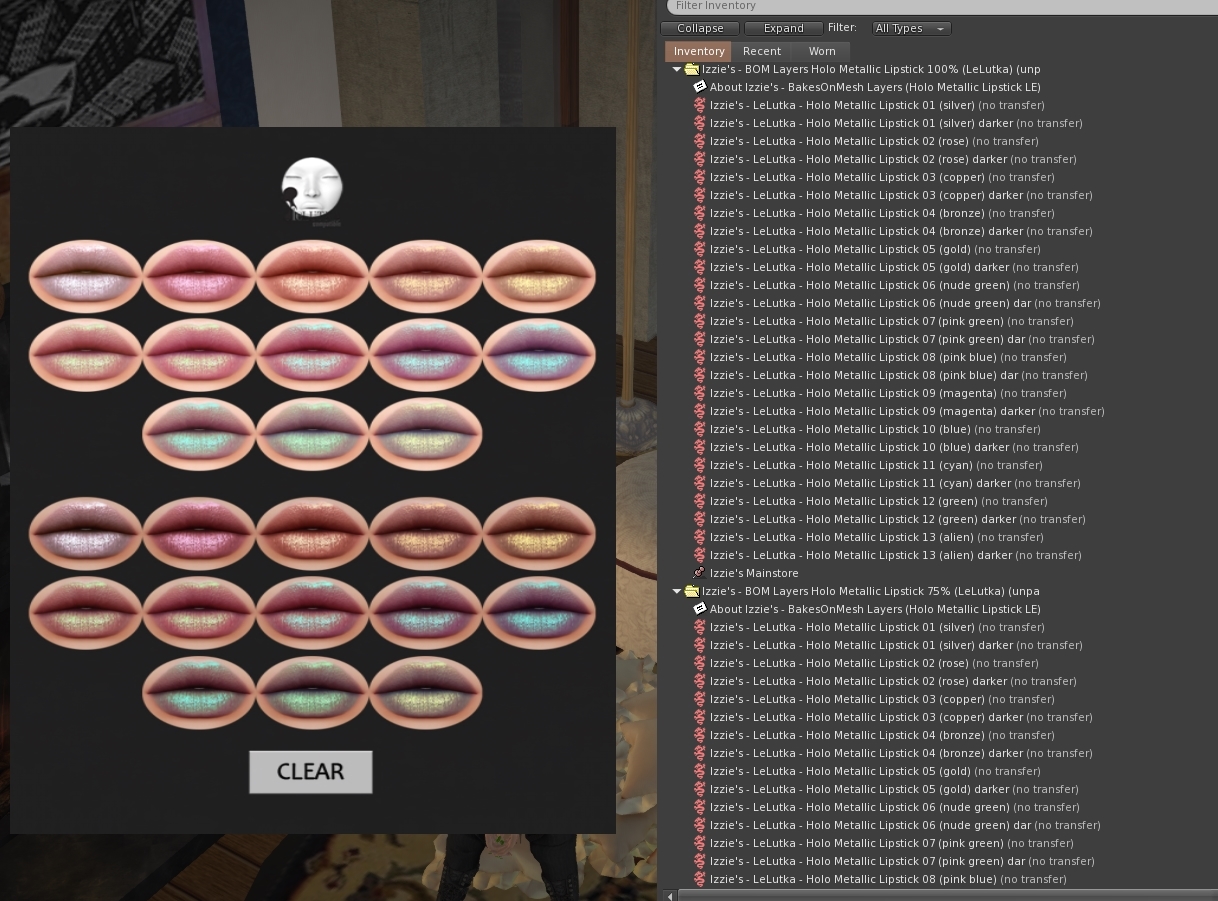Vir Linden commented at 2020-02-05T19:39:28Z
I'm not sure how this would work. The bake service is based on finding wearables in the current outfit and then compositing them. If we want to allow a user-settable transparency value, how does this get encoded in the outfit? I suppose it could get wedged into the item links in the outfit - the description field contains ordering info, maybe could add more fields there.
I will import this as possible BOM follow-on work.
How would you like the feature to work?
Bakes On Mesh is expected to bring about the demise of the burden of onion layer avatars which add considerably to the rendering time for an avatar. At present however, the move to "proper" BOM mesh body results in a reduced user experience in a number of ways. This Jira is one of a series that proposes potential features to address this.
A "proper" BOM body, for the purpose of these jiras is one that eliminates all unnecessary onion skin layers mesh, as opposed to those that persist with existing onion meshes and a HUD relay that allows the BOM textures to be specified as the base layer.
Request: Add blending/transparency to the COF appearance editing floater.
Each worn bakeable layer is currently presented with arrows to allow it to be positioned in the bake stack. I propose adding a blending function to this to allow the bake service to offer the same level of functionality that is currently enjoyed by the onion skin meshes.
The following is a mockup of a potential UI
Why is this feature important to you? How would it benefit the community?
Onion skin mesh avatars, most commonly on heads, allow the "blending" of layers such as the lipstick and eyeliner, this gives the user some control over how the item is applied and the intensity of the result. Currently BOM is unable to provide anything like this and as a result creators are resorting to making multiple instances of eaach wearble, each with a different level of transparency. This creates unnecessary clutter in the inventory and is even so still less flexible that the simple slider on the mesh HUDs.
By way of illustration, in the following image we see the HUD pallette of 26 tones. Each of these can then be blended (0-100%) using the heads own HUD to give a much wider range of effects. In contrast the BOM assets listed can achieve just two variations, 100% and 75% opacity, and require 52 distinct wearable assets (26 for each).
Original Jira Fields
| Field | Value | | ------------- | ------------- | | Issue | BUG-228156 | | Summary | BOM: Reducing inventory clutter by allowing blending/transparency in tattoos | | Type | New Feature Request | | Priority | Unset | | Status | Accepted | | Resolution | Accepted | | Labels | bakesonmesh | | Reporter | Beq Janus (beq.janus) | | Created at | 2020-01-31T02:29:32Z | | Updated at | 2022-05-14T01:15:03Z | ``` { 'Build Id': 'unset', 'Business Unit': ['Platform'], 'Date of First Response': '2020-02-05T13:39:28.076-0600', 'How would you like the feature to work?': 'Bakes On Mesh is expected to bring about the demise of the burden of onion layer avatars which add considerably to the rendering time for an avatar. At present however, the move to "proper" BOM mesh body results in a reduced user experience in a number of ways. This Jira is one of a series that proposes potential features to address this.\r\n\r\nA "proper" BOM body, for the purpose of these jiras is one that eliminates all unnecessary onion skin layers mesh, as opposed to those that persist with existing onion meshes and a HUD relay that allows the BOM textures to be specified as the base layer.\r\n\r\nRequest: Add blending/transparency to the COF appearance editing floater.\r\n\r\nEach worn bakeable layer is currently presented with arrows to allow it to be positioned in the bake stack. I propose adding a blending function to this to allow the bake service to offer the same level of functionality that is currently enjoyed by the onion skin meshes.\r\n\r\nThe following is a mockup of a potential UI\r\n\r\n!https://i.gyazo.com/f59f27131cd082620d77648b978412a2.png!\r\n\r\n\r\n', 'Original Reporter': 'Beq Janus (beq.janus)', 'ReOpened Count': 0.0, 'Severity': 'Unset', 'Target Viewer Version': 'viewer-development', 'Why is this feature important to you? How would it benefit the community?': 'Onion skin mesh avatars, most commonly on heads, allow the "blending" of layers such as the lipstick and eyeliner, this gives the user some control over how the item is applied and the intensity of the result. Currently BOM is unable to provide anything like this and as a result creators are resorting to making multiple instances of eaach wearble, each with a different level of transparency. This creates unnecessary clutter in the inventory and is even so still less flexible that the simple slider on the mesh HUDs. \r\n\r\nBy way of illustration, in the following image we see the HUD pallette of 26 tones. Each of these can then be blended (0-100%) using the heads own HUD to give a much wider range of effects. In contrast the BOM assets listed can achieve just two variations, 100% and 75% opacity, and require 52 distinct wearable assets (26 for each).\r\n!https://i.gyazo.com/ce723876dfaee5156689044cfb001753.jpg!\r\n', } ```